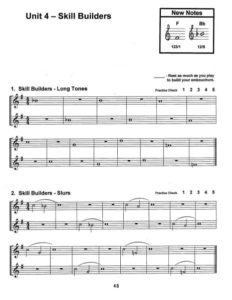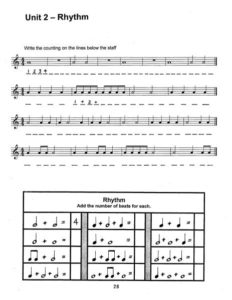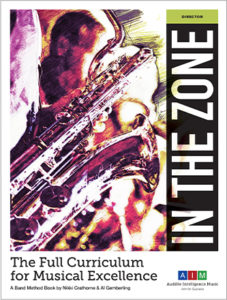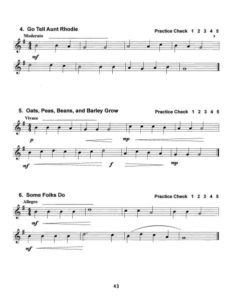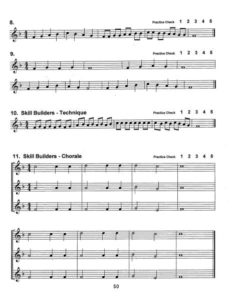Table of Contents
In The Zone
A Playbook for Musical Excellence
Teachers Guide
Students are actively engaged ….. “In The Zone”…. when using this book. In The Zone A Playbook for Musical Excellence Teachers Guide
In The Zone A Playbook for Musical Excellence Teachers Guide In the Zone is a complete curriculum!!!! There is no more need to gather supplemental materials to teach all of the basic musical concepts. We have done all of the work of getting the materials together which allows you, the teacher, to spend your valuable time teaching your students.
In The Zone A Playbook for Musical Excellence Teachers Guide
What is “In the Zone”?
In The Zone A Playbook for Musical Excellence Teachers Guide “In the Zone” is a new approach to music education. It provides a measurable way for students to progress through the basic fundamentals of music. Concepts are presented repeatedly in different ways so that students will not only recognize them but they will understand and apply them. New concepts are not just mentioned at the top of the page….. with “In the Zone” students are actively involved in learning.
Why “In the Zone?”
As music educators dealing with beginning through college levels, we have noticed that there are some gaps that occur in the existing methods available. Most concepts are left to the teacher to present and review. Other books provide music but not a systematic approach to successfully present all of the key elements needed to be a well-rounded musician.
Who should use “In the Zone”?
In the Zone is appropriate for any age music student. It is a great first method to complete as a requirement to enter an advanced ensemble. In the Zone was originally designed for the classroom but is also excellent for use in small groups or private instruction as well.
How to use “In the Zone”…..
In the Zone is designed to be completed one unit at a time. There is flexibility within the unit as to what order it is completed. Student and teacher check-off sheets are included to help monitor progress.
Student Practice Checks
Each unit begins with a student practice check page. This is where the student records what they have completed in the unit. Each Skill Builder and Song in the book has a practice check above it. When a student has practiced a selection they put an “X” through the number “1” above that selection. When they have completed all of the exercises one time, they may record their accomplishment on the practice Check page. Students should do all of the items once before proceeding to check off number “2”. Students must review each item “5” times before they complete a unit. Each time the selection must improve before the student should put an “X” on the next number. Students also record completed Theory, Rhythm and Composition on their practice check page.
Teacher Check-off Sheets
We have included teacher check-off pages to help teachers with multiple classes keep track of class progress. Please feel free to reproduce these as needed.
Skill Builders
Skill Builders help the student develop the basic skills needed to succeed as a musician. Isolating each of these skills and developing them progressively is crucial for proper development.
Skill Builders are written in two-parts
- Helps keep the mind focused
- Provides equal amounts of resting and playing to help develop the embouchure
Practice Options
- Woodwinds play line A and Brass buzz line B on their mouthpiecesThis helps the brass develop toneRepeat with brass playing their instruments
Only one or two buzzing exercises is recommended per day
Basses can play either line to support the wind instruments
- Have a soloist or section play one line while the rest of the class plays the other This is a great way to give individualized attention while everyone is participating
- Have a teacher or advanced student play line A to model desired sound while other students play line B.
- Have entire class clap and count each exercise before they play it. Percussionist can do “stick clicks” or play on the rims of the drums to make it easier to monitor the rhythmic accuracy. Everyone clapping will be doing one rhythm and the percussion will be “stick clicking” another rhythm.
- Have entire class sight sing each exercise before playing it.
Sight singing using note names and appropriate fingerings on instruments is a wonderful way to connect note reading, fingerings, and pitch internalization.
Sight sing using your preferred method.
Long Tones
Objective: To develop tone quality
- Focus on a relaxed and steady tone
- Develop proper breath support
- Practice controlling the beginning and ending of the notes
- This is a great time to check for proper embouchure and playing position
Slurs
Objective: To build embouchure and flexibility
- Focus on a consistent sound between notes
- Visualize the sound going straight rather than up and down to avoid excessive movement
Scales
Objective: To learn new notes and musical patterns
- Say the note names with a steady beat
- Play from memory
- Make sure students can read and play the notes in one unit before proceeding to the next unit.
Technique
Objective: To coordinate the tongue and fingers
- Start slow and increase speed
- Maintain accuracy as you gain speed
Chorale
Objective: To listen for proper blend and balance
- Apply quality tone to ensemble playing
- Listen for other parts
- Develop a sensitivity to balance and blend within a section and between partsIn The Zone A Playbook for Musical Excellence Teachers Guide
Theory
Each unit contains a theory lesson in each of the following areas. Each topic is reviewed and progresses through 10 levels to ensure optimum retention.
Note Reading
There is a note identification worksheet that specifically targets the notes used in the current unit. This is a great way for the student to review and demonstrate their ability to identify notes.
Piano Keyboard
The ability to visualize a keyboard can be very helpful in many areas of music. This section starts out with identifying the white keys. It progresses through the sharps and flats and covers enharmonic names for each note.
Key Signatures
The key signature lessons start by learning the order of sharps and flats. The lessons progress to properly identifying key signatures and applying accidentals to notes altered by the key signature.
Notation
Students see music notation on the page but there is a deeper understanding of how music is notated when students write it themselves. Keep high standards for your students in this area. Make sure they are paying attention to detail with their notation. You can learn a lot about their understanding of music by observing their notation.
Time Signatures
We have included basic exercises to help students understand different time signatures. They learn to determine how many beats are in a measure, what kind of note gets a beat, and how to put together different combinations of notes and rests to fill a measure in a given time signature.
Transpositions
Learning to transpose is necessary for students playing transposing instruments. We have developed a system where everyone learns to transpose for all instruments. This helps everyone better understand how music works and helps prepare students to write music for any instrument.
Dynamics
Proper use of dynamics is key to a great performance. We want students to be aware of them and make it part of their sight reading. Exercises are presented in different forms to ensure student comprehension.
Scale Spelling
We start by making students aware of the musical alphabet and the fact that there is one of each letter in a basic scale. We progress along with key signatures, to a point where students can write out a scale when given only the corresponding key signature.
Terms and Symbols
Each unit reviews basic terms and symbols so that the student will recognize them in a piece of music and will know what they represent. Isolating these terms and symbols makes learning them less intimidating than while trying to read notes, count rhythms, and get proper fingerings.
Rhythm
Rhythm is a major part of music so we have given extra attention in this area. We have included two worksheets in each unit that approach rhythms from different views. We also included a rhythm ensemble in each unit that can be clapped, played with sticks on chairs, played on instruments or anything you can come up with. We strongly encourage you to clap and count every exercise in the book before you play it with your ensemble. We have done this and the results have been amazing.
Songs
Each unit contains songs that consist of the notes, rhythms, key signatures, etc. that have been presented in the unit.
Rounds and Trios
We have included rounds and trios to help students develop independence. Please feel free to be creative in dividing your group into the different parts.
Composers
Starting with unit 3, a composer is highlighted in each unit. There is a short biographical section followed by some questions to ensure student understanding. We have included a composition by the composer so the students can associate the work with the composer.
Composition
Students put together what they have learned in the unit and write a composition of their own. If a student can write their own piece they demonstrate a true understanding of the concepts they have been studying.
In The Zone A Playbook for Musical Excellence Teachers Guide

